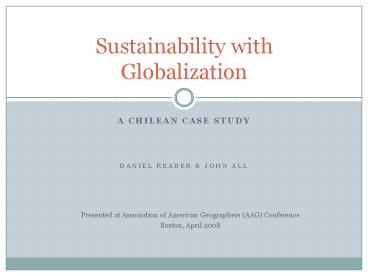A Chilean Case Study - PowerPoint PPT Presentation
1 / 19
Title:
A Chilean Case Study
Description:
Globalization is having marked effects throughout Chile ... Chile's medial positions with respect to both the globalization indices and the ... – PowerPoint PPT presentation
Number of Views:154
Avg rating:3.0/5.0
Title: A Chilean Case Study
1
Sustainability with Globalization
- A Chilean Case Study
- Daniel Reader John All
Presented at Association of American Geographers
(AAG) Conference Boston, April 2008
2
Sustainability
- Jha Murthy (2003) publish the Environmental
Degradation Index (EDI), ranking 174 countries
across a composite (by PCA) of six indicators - Fresh water withdrawals/capita/annum
- Fresh water withdrawals as pct. of water
resources - Printing and writing paper consumption/capita
- Carbon dioxide emissions/capita
- Share of world total CO2 emissions
- Rate of deforestation
3
Globalization
- Foreign Policy (2004) publishes ranked list of 62
countries across 14 globalization indicators - Trade Portfolio Capital Flow
- Foreign Direct Inv. Investment Income
- Intl Phone Traffic Intl Travel Tourism
- RPT Internet Users
- Internet Hosts Secure Servers
- Intl Org Membership UN Peacekeeping Cont.
- Intl Treaties Ratified Government
Transfers
4
Globalization vs. Sustainability
- Intersection of two indices is 61 countries
- How to compare ranked data? PCA is out
- Multidimensional Scaling (MDS) is the answer
- Heady Lucas (1995) introduce PerMap, an MDS
analysis tool available for (free!) download - PerMap ordination generates a display of a
non-metric best fit between the order of
dissimilarity and the order of distance contained
in the point-attribute matrix, similar to
hierarchical cluster analysis.
5
Environmental Degradation with Globalization
6
Within-Group Variability
- Initial values for coefficients of determination
(Rsq) ranged widely from .056 to .850 - Within-group test of globalization variables
disclosed four indicators with Rsq values below
0.333 Treaties, RPT, Trade, and Government
Transfers - Of the remaining 10 globalization variables, four
indicators had the highest regression strength
(Rsq values all gt .910) Telephone, Internet
Users, Internet Servers, and Secure Servers all
related to communication
7
Between-Group Variability
- All four communication indicators had very high
regression strength (Rsq gt.840) with respect to
the EDIr - With high regression strength, both within
communications indicators, and between them and
EDI, identity is approached - Four communications indicator values are summed,
on the basis of assumed minimal stochastic
variability CIR results
8
Environmental Degradation with Communication
9
Socioeconomic Conditions in Chile
- Copper, lumber, and farm-raised salmon top
exports, with produce worthy of note - Population growth is leveling, but GDP is on the
rise - Emerging industrial economy transitioning to
service economy - Per capita consumption and waste production on
par with advanced industrial nations
10
Anticipated Environmental Effects
- Deforestation, with attendant soil erosion, and
perhaps desertification - Diminished soil quality due to monocropping
- Diminished or depleted water sources
- Diminished water quality due to agricultural
fertilizer, herbicide, and pesticide runoff
mining runoff and industrial and domestic
effluents - Eutrophication along shorelines due to
aquacultural feeds and fecal matter from fishstock
11
Cities Observed
12
Desertification
13
Effects of Monocropping Tree Farms
14
Agricultural Runoff
15
Phytoplankton Blooms
16
Economic Destabilization/Marginalization
17
Environmental Vulnerabilities
- Market-driven pressure to continue to export raw
or minimally processed materials is
unquestionably the greatest single threat to
Chiles environment. - Losses in fisheries, due directly to overfishing,
and to aquaculture indirectly, destabilize
ecosystems. - Biodiversity is further threatened by
deforestation and massive tree plantation
efforts losses have already been devastating,
and irreparable in the foreseeable future. - Soil degradation due to monocropping,
salinization, and desertification are already
beginning to be problematic, and the trend is
increasing.
18
Economic Vulnerabilities
- Globalization has fed a resource extraction
economic ethos. - Chiles resource base (copper, wood chips, fish,
and produce), in conjunction with its open-arms
policy regarding global trade, render it a prime
target for environmental exploitation. - Natural copper deposits seem inexhaustible, but
Chile does little more with this resource than
auction it off. Liquidation cannot be a sound
strategy for long-term economic stability.
19
Conclusions
- Globalization is having marked effects throughout
Chile - Most anticipated effects were observed in at
least moderate degrees some were quite severe - Chiles medial positions with respect to both the
globalization indices and the environmental
degradation index appear to be valid - It may be concluded that globalization has a
negative impact upon the potential for
sustainability in Chile.































